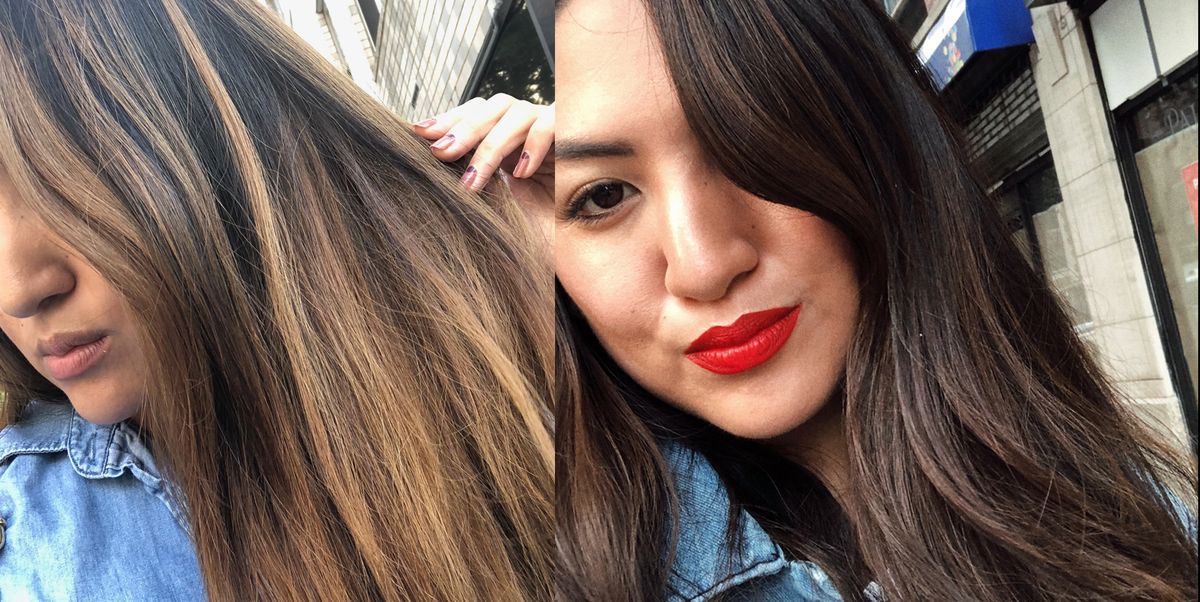

If you want the impact of a dye job without the commitment, a hair gloss is your best bet. Last year, I dyed my naturally dark hair nearly blonde, but didn’t do a great job of maintaining its color. I didn’t visit every four to six weeks as recommended, I didn’t take care to use specific shampoos, nor use protecting products. The result was the dry, hay-like brassy color you see above. When I finally sought help from my colorist, I was introduced to the magic of hair glosses. After less than an hour in the salon, I walked out with healthy-looking, shiny, and newly darker hue.
Ahead, colorist Lucille Javier of New York’s Sally Hershberger Salon on everything you need to know about this treatment.
What is a hair gloss?
A gloss is a temporary treatment that can help with both the health of your hair and its shade. “Glosses typically help with shine and evens tones,” Javier says. “Depending on what you want to achieve, it can be anything basically!”
What are the different types of gloss?
“Semi permanent gloss is typically a professional product—pigment mixed with developer. Direct dyes have just pure pigment and basically stain the hair,” Javier says. ” There are many types of hair glosses, depending on your color. If your color is lighter or darker could determine how often a gloss is necessary,”
Can glosses be an alternative to dye?
“Yes for sure!” Javier says. “If you don’t have much grey, there are ways to blend in your color. Blondes can definitely get away with glossing your hair different tones, even if it’s just your ends. Also, if you hair is light enough, you can just deposit tone on the hair.”
How do glosses help with handling brassiness or discoloration?
A gloss can help “fine tune” a shade to be more even, darken, or brighten the existing color. “It’s mixed specifically for a client and their needs,” she adds. “I have clients who enjoy coming in for a gloss more frequently because of the high shine and the subtle difference in the hair.”
Though she advises you ask your salon for the best recommendations, Javier broke down the following suggestions for dyed hair:
For red/strawberry blonde: “Red is one of the colors that fade very fast. Glosses are more frequent depending on how saturated the color is. Dark red or auburn hair tends to need less color, while strawberry blondes need more upkeep.”
For dark/ light blonde: “Depending on tone of hair—think of silver-blondes or very pale white—glosses tend to be done more frequently.”
Darker hair: Javier says dark tones “can get away with coloring hair less.”
How long does a gloss typically take?
“Not long at all, five to 30 minutes,” Javier says, adding that she regularly checks on the hair during the process because everyone’s hair has different porosity. “Some tones can grab quickly, but maybe someone with thicker hair may take longer,” she explains.
How often should you get a gloss?
Javier notes it depends on how complicated the color is, but every four to six weeks is a good rule of thumb. “The more you gloss, I believe you hold a higher standard to the color,” Javier claims.
How long do glosses last?
“Glosses are basically a ‘watercolor’ effect for any color. It depends how saturated the color is,” Javier says. “They last about a month, using color safe-conditioner and using cooler temperature water keeps the color in longer.”
What are some good at-home glosses?
Letting a professional apply gloss is best, but if you’re a fan of DIY Javier does vouch for Wella Color Touch or Redken Shades. “There are not any drugstore colors I suggest, they are a big no-no! They tend to have too much pigment and are very hard to remove,” she explains. “If very necessary to tone hair, color conditioners are amazing and equally as beneficial. Overtone is an amazing brand!”
Be the first to comment